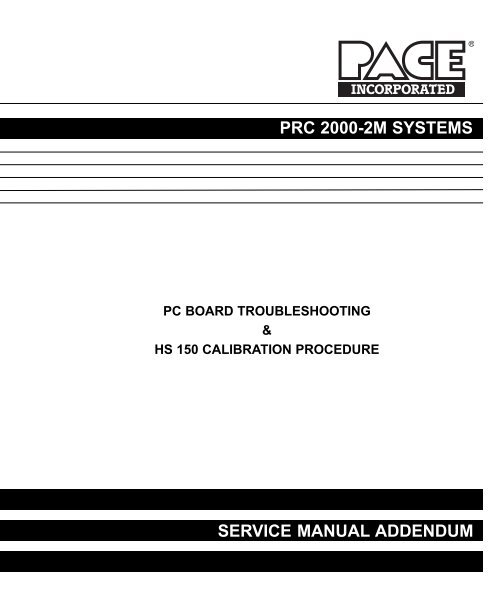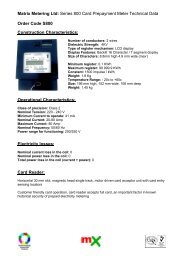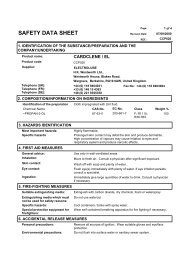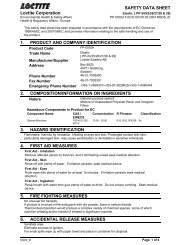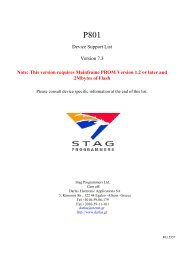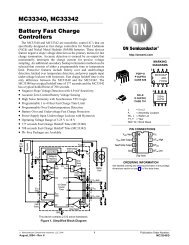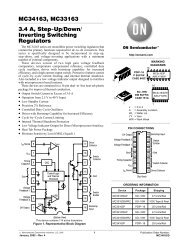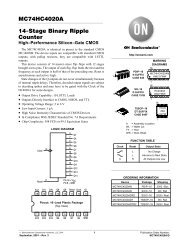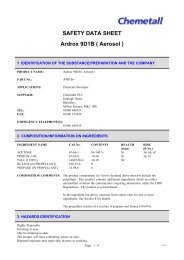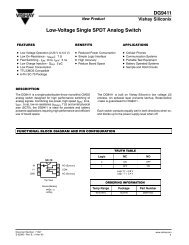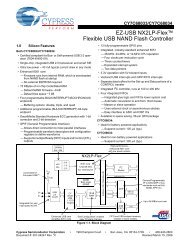PRC 2000-2M SYSTEMS SERVICE MANUAL ADDENDUM - Darlas
PRC 2000-2M SYSTEMS SERVICE MANUAL ADDENDUM - Darlas
PRC 2000-2M SYSTEMS SERVICE MANUAL ADDENDUM - Darlas
Create successful ePaper yourself
Turn your PDF publications into a flip-book with our unique Google optimized e-Paper software.
<strong>PRC</strong> <strong>2000</strong>-<strong>2M</strong> <strong>SYSTEMS</strong><br />
PC BOARD TROUBLESHOOTING<br />
&<br />
HS 150 CALIBRATION PROCEDURE<br />
<strong>SERVICE</strong> <strong>MANUAL</strong> <strong>ADDENDUM</strong>
<strong>MANUAL</strong> NO. 5050-0365<br />
REV. B<br />
1
INTRODUCTION<br />
The following pages detail theory of operation and procedures for troubleshooting both the Microprocessor PCB<br />
and Multifunction PCB assemblies and calibration of the HS 150 system. The included pcb troubleshooting Flow<br />
Charts will assist the technician in determining the source of a malfunction down to circuit area or component<br />
level.<br />
If you should encounter any difficulty in trouble shooting the pc boards or calibrating the HS 150, contact PACE<br />
Customer Service at TEL. (301) 490-9860, FAX (301) 604-9215.<br />
2
MICROPROCESSOR PCB ASSEMBLY<br />
THEORY OF OPERATION<br />
GENERAL DESCRIPTION<br />
The PACE part number 6020-0072 microcontroller (Microprocessor) board is the control for the Thermal<br />
Management Center section of the <strong>PRC</strong><strong>2000</strong> Repair center. The main purpose of the board is to measure and<br />
control the handpiece temperature established by the operator. Refer to schematic “Microprocessor PCB<br />
Assembly Schematic” in this manual or PACE drawing number 5000-0281.<br />
POWER SUPPLY<br />
The transformer secondary AC is rectified by the bridge rectifier and filters to +14 Vdc, and -14 Vdc and fed into<br />
the board of J5. The +14 Vdc is fed into regulator U1 that regulates the voltage down to +5 Vdc. The -14 Vdc is<br />
fed into regulator U2 which regulates it down to -5 Vdc.<br />
ZERO CROSSOVER DETECTOR<br />
Comparator U8D is used as a zero crossover detector. AC<br />
voltage from the transformer is rectified by diodes CR3 and<br />
CR4 to produce a rectified unfiltered voltage signal at U8D<br />
pin 11 (Fig 1 signal “A”). Signal “A” is compared with a<br />
reference voltage to produce a low going signal at the time<br />
period that the AC voltage is crossing zero volts (Fig 1<br />
Signal “B”). Signal “B” at U8D pin 13 is the zero crossover<br />
signal that is used to enable the triggering circuits of the<br />
triacs at the zero crossover point.<br />
RESET, WATCHDOG, AND BROWNOUT CIRCUITS<br />
Figure 1. Zero Crossover Detector<br />
Comparator U8B is used as the reset and brownout detector. When power is first turned on, the unregulated +14<br />
Vdc charges C23 through R37 until voltage on C23 passes the 2 Vdc ref. voltage at U8B pin 6. The output of<br />
U8B (pin 1) will then go high and turn off Q4 which will remove the reset from the microcontroller. If the<br />
unregulated +14 Vdc falls below 6.8 Vdc the U8B will detect a brownout condition and continuously apply a<br />
reset to the microcontroller.<br />
Comparator U8A along with Q3 comprises the watchdog circuit. The microcontroller will supply a pulse stream<br />
out of U3 pin 17 if the program is executing properly. If the program fails, the pulse stream will stop pulsing Q3<br />
on and allow C21 to discharge causing U8A output (pin 2) to go low and turn on Q4, resetting the<br />
microcontroller. When the reset is applied to the microcontroller, R3 provides a feedback into the watchdog<br />
circuit to turn on Q3 and release the reset so that the microcontroller may restart its program.<br />
3
MICROPROCESSOR PCB ASSEMBLY<br />
DISPLAY DRIVER<br />
The LED display is multiplexed under software control. The power is supplied to the anodes for about 2.8 ms out<br />
of the 11.11 ms, from the driver transistors (Q13-Q16). The driver transistors are controlled from pin 36 through<br />
pin 39 of U3 (microcontroller). The information for the cathodes of the display is supplied through driver U5 and<br />
U6-10 with the current limited by RN5. Information to the cathode’s drivers is supplied from the microcontroller<br />
port 2 (U3 pin 21-28).<br />
VACUUM PUMP DRIVER<br />
The vacuum pump driver is comprised of transistors Q1 and Q17 which are controlled from both the<br />
microcontroller (U3 pin 13) and the handpiece switches. When a switch is activated low, base current will flow<br />
through Q1 base and R13. Q1 will turn on which in turn will turn on Q17 applying power to the motor of the<br />
pump. At the same time the voltage at U3 pin 13 will go low, letting the program know that a switch has been<br />
activated. The program will let the motor run at +28 Vdc for 150 ms and then it will start chopping the voltage at<br />
a 2KHz rate by bringing pin 13 low and cutting off the base voltage of Q1. When the switch is released the<br />
microcontroller will read pin 13 between chops (to see if the pin is not being held low by the switch) if pin 13 is<br />
high, the microcontroller will reset the pump state to off (pin 13 held high). Although Q1 may fail if the<br />
handpiece shorts and AC voltage is fed into the switch input, the zener diode CR8 will protect the<br />
microcontroller.<br />
BUZZER<br />
U8C comparator forms a 2.05KHz square wave oscillator that drives Q21, which in turn drives the audio<br />
transducer (LS1) at its resonant frequency. The driver is controlled by the microcontroller (U3 pin 11) holding<br />
the base of Q21 low to turn it off. The RESET will also hold the driver transistor (Q21) off through CR5.<br />
TRIAC DRIVER<br />
Output to the triac drivers takes place on the back edge of the fourth digit display signal. Before turning off the<br />
digit four display, the data on port two of the microcontroller is changed to the triac data and then turns digit four<br />
off (signal going high), which clocks the triac data into U7. U7 is an eight bit latch that holds the triac<br />
information. The output of the latch is enabled with the zero crossover signal which allows any output that has a<br />
high latch within to turn on the associated triac. The microcontroller (U3) output from pin 10 will allow the<br />
microcontroller to turn off all triacs at once through CR1. The high signals from U7 drive inverter U6 to turn on<br />
the transistors that drive the current into the gates of the triacs. Each power triac driver has two drive transistors<br />
to allow the triacs to be triggered from a negative voltage, so that the trigger will be in quadrant two, and quadrant<br />
three. R11 is in series with the auxiliary triacs to limit the output current if a handpiece is plugged into the<br />
auxiliary outputs.<br />
4
MICROPROCESSOR PCB ASSEMBLY<br />
RTD CONSTANT CURRENT SOURCE AND CHANNEL MULTIPLEXOR<br />
U9A makes up a constant current source that provides the current excitation for the RTD (in the connected<br />
handpiece). The current is multiplexed to one of six RTDs to be measured. U9B amplifier feeds back the RTD<br />
voltage to modify the constant current source to correct for the non-linearity of the RTD. U11 is a dual eight<br />
channel multiplexor under control from the microcontroller (Mux A - Mux C signals). The multiplexor will<br />
switch the constant current source to each of the RTDs and switch the RTDs voltage up to the analog to digital<br />
converter (U10). CR9 and CR10 are in series with the multiplexor power inputs so that if the heater voltage feeds<br />
back onto the RTD input, the voltage will be fed through the input diodes of the multiplexor; and the power rail<br />
will float up to the input voltage and protect the chip (U11) from damage. Channel seven and eight of the<br />
multiplexor switch in the two very high precision calibration resistors every four minutes to allow the<br />
microcontroller to dynamically re-calibrate the RTD measuring circuits. R48 is the low calibration resistor (32°F),<br />
and R50 is the high calibration resistor (987°F).<br />
ANALOG TO DIGITAL CONVERTER<br />
U10 is a dual-slope-integrating analog to digital converter front end. Under control from the microcontroller<br />
(ADC A and ADC B signals), the dual-slope-converter will integrate the input for 16.6 ms into C25 and time the<br />
deintegration to the reference voltage. The microcontroller will then use the two times, and the reference voltage,<br />
to calculate the temperature of the RTD.<br />
KEYBOARD INPUTS<br />
The microcontroller (U3) drives the keyboard directly by providing the row drive (low signal) to the keyboard out<br />
of pin 1 and pin 2. After a row has been selected, the microcontroller will read the keyboard data from pins 3, 4,<br />
and 5.<br />
EEPROM MEMORY<br />
U4 is a 1024 bit Serial Electrically Erasable Programmable Memory. The microcontroller (U3) interfaces with<br />
the memory through a serial interface using U3 pin 14 to select the memory chip, U3 pin 15 to clock the data into<br />
the chip, and pin 16 to supply and read the data.<br />
5
MICROPROCESSOR PCB ASSEMBLY<br />
ERROR CODES<br />
There are certain error codes that may show up on the Digital Readout (display), if the program detect a fault<br />
within the system. These Digital Readout errors are listed below with the probable cause (fault) and the probable<br />
repair solution.<br />
1. “ E “ in the middle of the Digital Readout. This error indicates an error on power-up when the system<br />
program is checking the Random Access Memory or when comparing the sum-check against the store<br />
sum-check. The microcontroller (U3) will require replacement.<br />
2. “E-1” on the Digital Readout. This error indicates that the system program has detected a high<br />
resistance on the sensor input (RTD open). Check the handpiece, J1 connector, RTD Constant current<br />
source, channel multiplexor, and Analog to Digital converter.<br />
3. “E-2” on the Digital Readout. This error indicates that the system program has detected a low<br />
resistance on the sensor input (RTD shorted). Check the handpiece, J1 connector, RTD Constant<br />
current source, channel multiplexor, and Analog to Digital converter.<br />
4. “E-3” on the Digital Readout. This error indicates that the system program has detected an RTD<br />
resistance on the sensor input greater then the referenced resistance for 1000°F, but less then the<br />
resistance required to cause an “E-1” error (Digital Readout overflow). Check the handpiece, J1<br />
connector, RTD Constant current source, channel multiplexor, and Analog to Digital converter.<br />
5. “E-4” on the Digital Readout. This error indicates that the system program has detected an RTD<br />
resistance on the sensor input lower than the referenced resistance for 32°F, but higher than the<br />
resistance required to cause an “E-2” error (Digital Readout underflow). Check the handpiece, J1<br />
connector, RTD Constant current source, channel multiplexor, and Analog to Digital converter.<br />
6. “E-5” on the Digital Readout. This error indicates an incorrect resistance for the calibration resistors<br />
(R48 and R50). Check the calibration resistors R48 and R50, RTD Constant current source, channel<br />
multiplexor, and Analog to Digital converter.<br />
FLOW CHARTS<br />
The following Flow Charts should be used to determine the source of the Microprocessor board malfunction<br />
down to a circuit area or component level.<br />
6
MICROPROCESSOR PCB ASSEMBLY<br />
PAGE 1 OF 3<br />
Figure 2. MicroProcessor PCB Troubleshooting<br />
7
MICROPROCESSOR PCB ASSEMBLY<br />
PAGE 2 OF 3<br />
Figure 2. MicroProcessor PCB Troubleshooting Cont'd<br />
8
MICROPROCESSOR PCB ASSEMBLY<br />
PAGE 3 OF 3<br />
Figure 2. MicroProcessor PCB Troubleshooting Cont'd<br />
9
MULTIFUNCTION PCB ASSEMBLY<br />
THEORY OF OPERATION<br />
GENERAL DESCRIPTION<br />
The PACE Multifunction Board (P/N 6020-0074) is used in the PPS 400 power source to provide status and<br />
control for Pulse Heat, Pulse Plate, Paste Dispenser, Pik-Vac, and MicroChine functions. The board interfaces to<br />
front panel controls and indicators via wire harnesses. It also interfaces to power supply voltages, the Pulse Heat<br />
transformer, Pik-Vac vacuum pump, and Paste Dispenser motor pump assembly.<br />
Refer to “Multifunction PCB Assembly Schematic” & “Wiring Diagram” of this manual or PACE schematic<br />
5000-0283 and wiring diagram 5000-0284 for circuit and interconnect information when reading this document.<br />
POWER SUPPLY<br />
All supply voltages are routed on-board via wire harness connected at J31. The board operates from dual,<br />
complementary, unregulated 14Vdc supplies and regulated +5Vdc. The complementary +14Vdc and -14Vdc are<br />
produced by a 21 VCT transformer, bridge rectifier, and filter capacitors - all off-board and chassis-mounted.<br />
Regulated +5Vdc is produced on the 6020-0072 PPS 400 Microprocessor (controller) Board and routed onto the<br />
Multifunction Board at J31-5. The 21 VCT transformer secondary voltage, center tap, and chassis ground also<br />
route on-board at J31.<br />
PULSE HEAT SECTION<br />
GENERAL<br />
Pulse Heat circuitry controls the operation of low-voltage, high-current hand pieces such as Lap-Flo and<br />
ThermoPart tools. The circuit phase-fires the line-voltage primary winding of the Pulse Heat transformer only<br />
when the foot pedal selector switch is set to PH and the foot pedal is pressed. The transformer secondary directly<br />
drives a Pulse Heat hand piece connected to front panel low-voltage AC output terminals. The effective<br />
handpiece power level is set by adjusting the Pulse Heat control potentiometer. The Pulse Heat LED lights green<br />
whenever the foot pedal is pressed while the selector switch is set to PH.<br />
If the Pulse Heat output of a power source is coupled to another unit’s Pulse Heat output, U10, Q25, and possibly<br />
the transformer may be damaged.<br />
10
MULTIFUNCTION PCB ASSEMBLY<br />
CIRCUIT OPERATION<br />
ZERO-CROSSING DETECTOR<br />
Diodes CR17 & CR18 provide full-wave rectification of the main power transformer’s center-tapped secondary<br />
voltage. The rectified voltage is applied to the voltage divider comprising R72 & R69, after transformer phaseshift<br />
compensation by C37. The voltage is divided down from about 10 VAC to 5VAC and applied to U6A-3,<br />
where it is compared to 316 mVdc at U6A-2. When the amplitude of the AC signal at U6A-3 is less than 316<br />
mVdc, U6A-1 output is low. When the AC signal at U6A-3 rises above 316 mVdc, U6A-1 output is high - the net<br />
effect being the production of a train of narrow, negative-going, zero-crossover detection pulses at twice line<br />
frequency.<br />
RAMP GENERATOR<br />
Each zero-crossing pulse forward-biases CR14, momentarily discharging C29 through R68 to a diode drop less<br />
that the buffered reference voltage from U6B-7. With C29 discharging, the summing-junction current imbalance<br />
at U6C-9 forces U6C-8 output high. The output remains high until the zero-crossover interval ends. At that time,<br />
current entering the summing junction at U6C-9 through R25 and C29 drives output U6C-8 low at a constant rate.<br />
The result is production of a periodic ramp (sawtooth) waveform. R61, U3A, CR7, R20, R21, C23 and U3B<br />
drive U6C-9 through R25, compensating for line frequency differences and ensuring that U6C-8 output waveform<br />
transitions from near ground to the positive supply rail.<br />
PULSE-WIDTH MODULATION CONTROLLER AND LINE INTERFACE<br />
The ramp waveform from U6C-8 is applied to U6D-13, where it is compared against the Pulse Heat control<br />
voltage (set point). The set point voltage is applied to U6D-12 if the foot switch is closed. When the foot switch<br />
is first closed, R71 & C36 slowly charge U6D-12 to the set point voltage, providing transformer “soft start”. The<br />
set point voltage is compared against the ramp waveform at U6D-13, providing pulse-width modulated output at<br />
U6D-14. The pulse-width modulated output of U6D-14 drives U10-1 through current-limiting resistor R70.<br />
Snubber R103 & C35 attenuate foot switch-generated EOS/ESD transients. CR22 protects the optocoupler LED<br />
from switching transients that exceed its reverse voltage rating. U10 triac conducts when the input LED is active,<br />
turning on power triac Q25. R122 & R123 provide gate current limiting. When Q25 turns on, line voltage at<br />
J34-1 is switched to the Pulse Heat transformer via J34-2. C50, C51, R124, and MOV1 protect the triac circuit<br />
from false triggering or breakdown due to line transients.<br />
11
MULTIFUNCTION PCB ASSEMBLY<br />
PULSE PLATE SECTION<br />
GENERAL<br />
Pulse Plate circuitry controls operation of SwaPlating electrodes. The Pulse Plate section of the front panel has<br />
two banana jacks to accommodate plating electrodes, a control potentiometer for setting electro-cleaning &<br />
plating voltages, and an LED to indicate status.<br />
CIRCUIT OPERATION<br />
PLATING VOLTAGE<br />
Diodes CR23 & CR24 provide full-wave rectification of the main power transformer’s center-tapped secondary<br />
voltage (10.5VAC1 & 10.5VAC2, respectively). The resultant unregulated, unfiltered, “pulsating” DC is used by<br />
the Pulse Plate circuit to perform electro-cleaning and plating functions.<br />
PWM CONTROLLER<br />
U3D is the Pulse Plate setpoint comparator. The same periodic ramp waveform (saw tooth) used for Pulse Heat<br />
PWM control is fed to U3D-13 and compared to the U3D-12 setpoint voltage. When the front panel selector<br />
switch is set to PP and the foot switch open, the control potentiometer CW terminal (J32-16) floats, applying +14<br />
Vdc as the setpoint voltage and forcing U3D-14 output high. When the foot switch is closed, the control<br />
potentiometer CW terminal is grounded and the pot wiper voltage is applied to U3D-12 as the setpoint voltage.<br />
Lower setpoint voltages increase the time the output is low (i.e. higher duty cycle) during the ramp waveform<br />
period. Low output at U3D-14 forward biases CR8, turning on Q24 through current-limiting resistor R23. While<br />
Q24 is on, pulsating DC current flows through the transistor out to the load via connector J33, the front panel “+”<br />
and “-” DC output jacks, and the SwaPlating tools. Normal load current flows unless there is a “short-circuit”.<br />
12
MULTIFUNCTION PCB ASSEMBLY<br />
FOLDBACK CURRENT LIMITING<br />
Foldback current-limiting is provided by the circuit comprising R118, R119, R120, R121, C49, CR26, Q18 and<br />
Q19. The typical “knee” value where foldback current limiting occurs is 3.4 A, DC average. Under short-circuit<br />
conditions, the average DC load current is typically less than 400 mA.<br />
STATUS LOGIC AND LED DRIVE<br />
The status logic and Led drive circuit comprises U9, Q5, Q11, Q12, R92-R99, C33, CR21, J32-7, J32-19, and<br />
J32-20. The Pulse Plate LED lights when the front panel selector switch is set to “PP” and the foot switch closed.<br />
During normal plating operation, Q5 is off and U9A-2 is pulled up to +14 V through R93, driving U9A-3 low.<br />
The low output is applied to U9B-5 through R94, driving U9B-4 inverter output high. The inverter output drives<br />
Q12 base through R97, turning off Q12 and the red LED at J32-20. The inverter output also is applied to a<br />
second inverter, U9C-8, which outputs low at U9C-10, turning on Q11 through R96. In the on state, Q11 turns on<br />
the green Pulse Plate LED through R99.<br />
In the event of an over-current condition, the foldback current-limiting circuit activates, and Q19 is on, driving<br />
Q5 base through R92. Q5 turns on, pulling U9A-2 low. U3D-14 PWM output is applied to U9A-1. The low<br />
portion of U3D-14 PWM output drives U9A-3 high. High output from U9A forward biases CR21, rapidly<br />
charging C33 through R95. The resultant high at U9B-5 drives U9B-4 output low. The low signal turns on Q12<br />
through R97, and the red Pulse Plate LED through R98. The low signal is also applied to inverter U9C-8, turning<br />
off Q11 and the green Pulse Plate LED. During the high portion of the PWM signal, U9A-3 is low and CR32 is<br />
blocking. C33 begins slowly discharging toward ground through R94. The large time constant of C33 and R94<br />
ensure that a logic high is maintained at U9B-5 throughout the remainder of the period of U3D-14 PWM output.<br />
The high at U9B-5 keeps the red Pulse Plate LED on as described above. When the over-current condition is<br />
removed, the foldback current limiting circuit turns off, Q5 turns off, and the green Pulse Plate LED lights again<br />
as described above.<br />
13
MULTIFUNCTION PCB ASSEMBLY<br />
PIK & PASTE SECTION<br />
THEORY OF OPERATION<br />
GENERAL<br />
The Pik & Paste section consists of circuits that control operation of the Pik-Vac vacuum pump and the Paste<br />
Dispenser paste pump and solenoid valve. The Pik-Vac has an on/off switch, LED, and vacuum fitting for a<br />
component pick-up hand piece (vacuum wand). The Paste Dispenser has a switch for selecting timed or<br />
continuous dispensing, a control potentiometer for setting dispensing time, a status LED, and quick-connect<br />
fitting for connection of a syringe containing solder paste, adhesive, or other material.<br />
PIK-VAC CIRCUIT OPERATION<br />
The Pik-Vac pump is connected between J31-8 and J31-2, and operates from 21 VAC. The pump operates when<br />
the front panel Pik-Vac switch is closed, completing the circuits connecting the pump and Pik-Vac LED and the<br />
21 VCT transformer secondary. With the Pik-Vac switch closed, 21 VAC is rectified by CR27, turning on the<br />
green Pik-Vac LED through current-limiting resistor R125. CR27 provides LED reverse-voltage breakdown<br />
protection. R126, R127, and C52 snub switch transients and reduce EOS/ESD in the system.<br />
PASTE DISPENSER CIRCUIT OPERATION<br />
RECYCLE TIMER<br />
When the front panel selector switch is set to “PD”, +14 Vdc is supplied to J32-24 from J32-32. R65 and C19 are<br />
connected to J32-32 and oscillator/timer IC U4’s Vcc pin. Vcc is connected to the MODE and Q/Q* pins,<br />
configuring the timer to output high initially after reset and to operate in the recycle mode. C19 charges up and<br />
powers U4 each time the selector switch is set to “PD”. U4-5 is grounded, enabling auto reset, and the chip resets<br />
all internal counters at power-up. U4 oscillator frequency is 8.7 Hz, nominal, and is set by R26 and C5. Time<br />
select inputs A and B are used to determine durations of low and high output at U4-8. The B time select input,<br />
U4-13, is connected to ground. The A time select input, U4-12, is connected to the timer output, U4-8, through<br />
R66. When a change of state occurs at the OUT pin, U4-8, R66, and C24 delay the new voltage level’s<br />
application to U4-12, the A time select input, to allow for internal settling.<br />
14
MULTIFUNCTION PCB ASSEMBLY<br />
When power is applied to U4, the timer automatically resets itself, and its OUT pin, U4-8 goes high. The B time<br />
select input is low, and the A select input goes high due to its connection to U4-8. This combination of time<br />
select inputs (along with MODE and Q/Q* inputs already discussed) programs the timer to output high for 256<br />
counts, approximately 14 seconds. After 256 counts, the output goes low, selecting U4’s internal ripple counter<br />
output for 8192 counts. Since 256 counts already have occurred in the internal ripple counter, the timer outputs<br />
low for the number of counts remaining to reach 8192, 7936 counts, approximately 7 minutes and 36 seconds.<br />
Thereafter, the cycle automatically repeats itself. The output goes high for 14 seconds, outputs low for 456<br />
seconds, then repeats. This cycle will continue until the front panel selector switch is set to a position other than<br />
“PD”, or the paste dispenser is activated by foot switch closure in either the timed or continuous mode, thereby<br />
forcing a reset through U4’s MR (master reset) pin, U4-6.<br />
PASTE DISPENSER PUMP DRIVE<br />
The paste dispenser pump operates from two motor voltages. The motor is started with full 28 Vdc. This “kickstart”<br />
voltage provides the additional power required by the motor when starting up against a pressurized pump<br />
and reservoir. The duration of the motor “kick-start” interval is established by C38 and R85. After the “kickstart”<br />
interval ends, 28 Vdc is replaced by a pulse-width modulated “run” voltage. This voltage operates the<br />
pump after motor start-up. The “run” voltage is 11 Vdc avg.<br />
The paste dispenser pump operates whenever U4-8 is at a logic high. When U4-8 output transitions high, the<br />
signal is applied directly to U7C-8 and coupled through C38 to U8D-13 via R86. C38 and R85 establish the<br />
duration of the motor “kick-start” interval. The high at U8D-13 drives U8D-11 low, turning on Q20 through R83.<br />
Current flows through Q20 collector out to the paste pump connected between J31-12 and J31-10. The pump is<br />
driven with approximately 28 Vdc. The low output from U8D-11 also routes to U7C-9. With both input<br />
terminals at different logic levels, U7C output is driven high. The high signal charges C4 through R24. When C4<br />
charges up, U3C-9 will momentarily go a little more positive than U3C-10, forcing U3C-8 low. When R85 has<br />
discharged C38 to near ground (40ms, nominal), the combination of logic low signals at U8D input terminals<br />
drives U8D-11 high, turning off Q20 and the paste dispenser pump. The high output from U8D is applied to<br />
U7C-9, forcing U7C-10 low. U7C-10 low output discharges C4 through R24 and R64. When the voltage across<br />
C4 drops to a little less than that at U3C-10, U3C-8 again goes high. The high is applied to U8D-12, driving<br />
U8D-11 low. The low at U8D-11 provides base drive through R83 to Q20, turning on the paste pump. R24, C4,<br />
and R64 will continue charging and discharging in this manner so long as U4-8 output is high. This provides<br />
PWM control of Q20 and the pump. The duty cycle is approximately 40% with a PWM frequency of about<br />
6kHz. The pump voltage is about 11 Vdc avg.<br />
15
MULTIFUNCTION PCB ASSEMBLY<br />
CONTINUOUS MODE OPERATION<br />
When the TIMED/CONT switch is set to “CONT” and the FOOT PEDAL selector switch to “PD”, pressing the<br />
foot pedal makes a closure to ground at J32-17, turning on Q9 through R87. Q9 collector goes high, providing<br />
base drive through R107 to solenoid driver transistor Q21. Q21 turns on, activating the solenoid valve connected<br />
between J31-13 and J31-14 by providing a path to ground. The NC valve opens, gating the paste dispenser pump<br />
and reservoir air supply to the front panel “PD” quick-connect. Concurrently, the high at Q9 collector is applied<br />
to timer U4-6 master reset input through R28, resetting the timer. The timer output goes high, initiating PWM<br />
drive of the paste dispenser pump as previously described. As long as the foot pedal switch is pressed, the closure<br />
to ground at J32-17 is maintained and the pump and solenoid valve are active. When the foot pedal switch is<br />
released, the high reset signal is removed from U4-6, and timer output U4-8 is high for 14 s, driving the pump<br />
and recharging the reservoir.<br />
TIMED MODE OPERATION<br />
When the “TIMED/CONT” switch is set to “TIMED” and FOOT PEDAL selector switch to “PD”, pressing the<br />
foot pedal makes a closure to ground at J32-29. The resultant low is coupled to the trigger input, U5-2, of the<br />
‘7555 timer through C7. The timer output terminal, U5-3, goes high, turning on the solenoid valve by driving<br />
Q21 base through R32 and R107. U5-3 high output also turns on the paste dispenser pump by driving its master<br />
reset input, U4-6, through R32 and R28. The ‘7555 timer output remains high, driving the pump and solenoid<br />
valve circuits for the time established by the resistance setting of a logarithmic pot between terminals J32-14 and<br />
J32-34. The ‘7555 timer’s chief function is to provide timed gating of air to the attached dispensing hand piece<br />
by accurately controlling its ON time. The timer output initiates paste dispenser pump turn-on at the same time as<br />
the solenoid valve, but once the ‘7555 timer output goes low and the solenoid valve closes, the paste dispenser<br />
pump continues to run for approximately 14s to replenish the reservoir. The pump will periodically recycle,<br />
automatically recharging the reservoir. Dispensing only can occur when the solenoid valve is activated and that<br />
occurs only when the foot pedal has been pressed.<br />
R102 establishes a minimum on time when the log pot is set to its minimum resistance value. The trigger circuit<br />
comprises snubber R33 & C8, and the trigger network of R30, C7 and R31. R34, C25, and CR13 form a poweron<br />
reset circuit. R35-R38 is a network with factory-set pot to improve timer accuracy by shifting the ‘7555 timer<br />
internal switching threshold.<br />
16
MULTIFUNCTION PCB ASSEMBLY<br />
STATUS LOGIC AND LED DRIVE CIRCUITS<br />
Paste dispenser status is determined by logic gates U7A, U7B, and U8C. R78, R80, R82, R84, Q6, and Q7<br />
provide Status LED drive. There are three status conditions: LED off, LED green, LED amber. When the Paste<br />
Dispense section is not selected or the pump is idle and not recharging, U4-8 and U5-3 are low. The low from<br />
U4-8 is applied to inverter U7A, which outputs high, keeping transistor Q6 and the green LED off. U5-3 low<br />
output is applied to inverter U8C through R32, driving U8C-10 high. The high is applied to U7B-6. The<br />
remaining input terminal is fed a low by U4-8, driving U7B-4 high, turning off Q7 and the red LED. If the Foot<br />
Pedal Selector Switch is set to “PD” for paste dispensing, but the foot switch is open and the pump is recharging<br />
the air reservoir, U4-8 output is high and U5-3 output is low. U4-8 high output is inverted by U7A, producing a<br />
low at U7A-3, turning on Q6 through R80. Q6 turns on the green PASTE DISP LED through R78.<br />
Concurrently, U8C inverts U5-3 low output, driving U8C-10 high. The resultant high at U7B-6 paired with the<br />
high at U7B-5 from U4-8, drives U7B-4 low. This low output turns on Q7 through R82. Q7 turns on the red<br />
PASTE DISP LED through R84. Since the red and green PASTE DISP LEDs are both on and contained within<br />
the same T1-3/4 package, the LED lights amber, indicating that the pump is recharging the reservoir. In the event<br />
that the foot pedal is pressed in either the timed or continuous operational mode, a high is applied to inverter<br />
U8C. In continuous mode, the high is produced by Q9; U5-3 drives the inverter through R32 in timed mode. The<br />
high input at inverter U8C produces low output which is applied to U7B-4. U4-8 is driven high by application of<br />
a high at its master reset input (from Q9 if continuous mode, U5-3 if timed). The high output from timer U4-8 is<br />
applied to inverter U7A and pin 5 of U7B. U7A output is low, turning on transistor Q6 through R80, and the<br />
green PASTE DISP LED through R78. The combination of logic high and low inputs at U7B, produce high<br />
output at U7B-4, keeping Q7 and the red PASTE DISP LED off. Hence, the PASTE DISP LED is green ,<br />
indicating that a dispensing cycle is in progress.<br />
17
MULTIFUNCTION PCB ASSEMBLY<br />
MICROCHINE SECTION<br />
GENERAL<br />
The MicroChine section consists of circuitry that interfaces to and controls operation of the MicroChine<br />
handpiece and probe brake patch cord. The Micro-Chine section has a front panel control potentiometer for<br />
setting shaft rotational speed (RPM), a handpiece connector, Probe Brake banana jack, and Status LED. The<br />
MicroChine handpiece is used for drilling, milling, probing and abrading operations.<br />
CIRCUIT OPERATION<br />
CLOSED-LOOP CONTROL CIRCUIT<br />
The MicroChine shaft speed is resolved by measuring the back EMF generated by the motor. The motor is driven<br />
by pulse width modulated (PWM) voltage. During each interval when the PWM motor-drive voltage is off, the<br />
motor coasts, producing a back EMF or “generator” voltage. The back EMF voltage is proportional to motor<br />
speed. This generator voltage is scaled by the voltage divider comprising R42 and R43, and filtered by C21.<br />
When back EMF is generated, CR2 is forward biased, and the scaled, diode-offset back EMF signal applied to op<br />
amp U1A-3. The op amp is configured as a voltage follower, buffering the back EMF signal and applying it<br />
through R4 to the summing junction of error amplifier U1D-13. The summing junction detects differences<br />
between the back EMF signal and the control pot RPM setting. R1 and R2 provide summing junction offset<br />
current compensation. R2 is set at the factory during calibration. The Variable Speed Control pot ends are<br />
connected in parallel with 18V zener diode CR11 at J32-1 and J32-31. The wiper voltage is routed on board via<br />
J32-28 and applied to R44, generating the set point current at the summing junction. Whenever the summing<br />
junction detects that the motor speed is less than the setpoint, U1D-14 output is driven high. U1D output is<br />
applied to comparator U1B-5 through the network comprising R5-R10, C12, C13, CR3, and CR4. When the<br />
handpiece is just turned on, R7 and C13 provide “soft-start” of the motor by slowly charging up to the error<br />
voltage. The divider consisting of R8-R10 and diodes CR3 and CR4 clamp U1D output over a narrow voltage<br />
range, limiting the error voltage. This conditioned error voltage signal provides improved motor response to<br />
changing shaft load, i.e., transients, and produces a “smoother” PWM output when U1B-5 is compared to the<br />
triangle waveform at U1B-6. The triangle waveform at U1B-6 is produced by the ramp generator comprising<br />
U1C, R47-R50, and C22. The signal is applied to U1B-6 through R41, and is a 300 Hz, nominal, signal varying<br />
from -8V to -2V. As the error voltage at U1B-5 increases, so does the width of the positive-going pulses at the<br />
comparator output, U1B-7. The comparator output is clamped by CR10, providing Q14 base-emitter junction<br />
reverse breakdown voltage protection. When the comparator output is high, it provides base drive to Q14 through<br />
R51. If the MicroChine handpiece switch is closed, or the Foot Pedal Selector Switch is set to “MC” and the foot<br />
pedal switch closed, Q13 is off and does not clamp Q14 base to ground. Thus, Q14 is permitted to turn on each<br />
time positive-going PWM pulses are applied unless the PROBE BRAKE latch is activated.<br />
18
MULTIFUNCTION PCB ASSEMBLY<br />
The PROBE BRAKE latch output, U2A-1 must be low for the MicroChine handpiece to run. The MicroChine<br />
motor runs when the handpiece switch is closed, or the Foot Pedal Selector Switch is set to “MC” and the foot<br />
pedal switch closed. When neither switch is closed and the PROBE BRAKE latch is off (U2A-1 output is low), a<br />
+5V control signal is applied through R16 and R13 to Q2 base, turning on Q3 and forcing U1D-14 output low.<br />
This shuts down PWM output from U1B after a slight delay (due to slew-rate and integrator effects) and thus, the<br />
motor drive transistor Q22. The motor control signal also biases Q16 on through R111. Q16 turns on Q17<br />
through R115. Q17 turns on brake transistor Q23 through R117, braking the free-wheeling motor when the<br />
switch is released. The control signal also is applied to Q13 base through R108, turning on Q13. Q13 keeps Q14<br />
off, clamping its base near ground. With Q14 off, Q22 base is pulled high through R105 and R109, cutting off<br />
the motor driver transistor virtually as soon as the switch is released.<br />
OVER-CURRENT DETECTOR/TORQUE LIMITER<br />
Motor torque is monitored and limited by the over-current detector/torque limiter. This circuit comprises R113,<br />
R110, R114, C47, Q15, R39, and CR1. Motor drive current flows through current-sense resistor R113.<br />
Instantaneous voltage drop develops across R113, proportional to instantaneous current draw of the MicroChine<br />
handpiece motor. The voltage across R113 is averaged by C47 and R110. Q15 acts as a comparator with a<br />
threshold of approximately 0.6 volts. If high motor torque develops (due to overload), the average voltage across<br />
C47 reaches 0.6 volts, and Q15 turns on. The collector voltage of Q15 forward-biases CR1, gating current<br />
through R39 to the error amplifier summing junction U1D-13. The amplifier output then signals the pulse-width<br />
modulator to slow down the motor, reducing motor drive current and torque.<br />
19
MULTIFUNCTION PCB ASSEMBLY<br />
MICROCHINE SECTION CONT’D<br />
PROBE BRAKE CIRCUIT<br />
The PROBE BRAKE circuit comprises C2, C3, C16, C17, CR5, CR6, R15, R17-R19, R57-R60, R128, U2A, and<br />
U2B. A voltage divider consisting of R17 and R18 provides low-voltage, low-current, safe excitation of a<br />
workpiece connected to a test lead plugged into the front panel PROBE BRAKE Receptacle. The front panel<br />
jack is connected to the divider via wire harness conductor terminating at J32-27. R128 provides input protection<br />
of buffer U2B. The 200 mVdc divider voltage is buffered by U2B, and applied to probe brake latch U2A through<br />
R60. Another voltage divider comprising R19, R58, and R59, applies a 100 mVdc reference voltage to U2A-3.<br />
The latch output, U2A-1, is low and remains at that level until the J32-27 is pulled down below 100 mVdc. In a<br />
typical application, this occurs when the MicroChine tip contacts the PROBE BRAKE test lead or part of a<br />
workpiece to which it is connected. When the PROBE BRAKE input is pulled below the 100 mVdc reference of<br />
the latch, it is applied through buffer U2B and R60 to U2A-2, the latch trigger input. The latch output goes high,<br />
driving CR6 into conduction, and shifting the latch reference voltage well above the 200 mVdc excitation<br />
normally applied by the buffer. Through this action, U2A output is latched high, even if the workpiece is<br />
disconnected from the PROBE BRAKE Receptacle. The latch is cleared by first allowing the excitation voltage<br />
to return to its 200 mVdc nominal value. Typically this is done by lifting the MicroChine handpiece away from<br />
the workpiece, breaking contact between the PROBE BRAKE excitation voltage and ground. (Ground is<br />
provided by any metallic MicroChine tip since the handpiece shaft is grounded.) Secondly, the handpiece or foot<br />
switch must be released momentarily, coupling a high through C16 and CR5 to U2A-2, temporarily raising its<br />
input voltage above the latch reference threshold voltage at U2A-3. This drives U2A output low, reverse-biasing<br />
CR6, and re-establishing the 100 mVdc reference voltage at U2A-3.<br />
The MicroChine handpiece PROBE BRAKE feature is supported by EOS/Chassis Ground being continuous with<br />
DC Circuit Ground through PTC1. This keeps the MicroChine shaft at ground potential for probing and provides<br />
fault protection in the event of a ground fault in the THERMAL MANAGEMENT CENTER (TMC) section of<br />
the unit. If a ground fault causes the PTC to enter its high-resistance state, the PROBE BRAKE circuit and its<br />
Status LED will activate and/or indicate.<br />
In addition to the grounded shaft, the MicroChine handpiece incorporates a bifilar-wound choke and a transzorb<br />
to minimize EOS/ESD transients.<br />
20
MULTIFUNCTION PCB ASSEMBLY<br />
STATUS LOGIC AND LED DRIVE CIRCUITS<br />
MicroChine operating status is indicated by a front-panel mounted tri-color Status LED. MicroChine status is<br />
determined by the states of the handpiece and foot pedal switches, the probe brake latch, and the over-current/<br />
torque-limiting circuit. During normal operation, either the MicroChine handpiece switch is closed, or the front<br />
panel Foot Pedal Selector Switch is set to “MC” and the foot pedal switch closed, lighting the Status LED green.<br />
When the torque-limiting circuitry is active, the LED is amber. The LED is red if the probe brake latch is on.<br />
The status circuit which detects a handpiece or foot switch closure comprises R11, R54, Q1 and U7D. The<br />
PROBE BRAKE latch output state is read by R76, R77, Q4, and U8A. Active torque-limiting circuitry is<br />
detected by the network consisting of CR20, R91, C39, and R90.<br />
During normal operation, the torque-limiter is off, pulling low U8B-5 through R90. Since the probe brake is also<br />
off during normal operation. Q4 is off, and U8A inputs are pulled high through R77, driving U8B-6 low. With<br />
both inputs low, U8B-4 output is at a logic high, keeping Q10 cut-off and the red Status LED off (J32-18).<br />
When the PROBE BRAKE latch is on, base current flows through R76, turning on Q4, and pulling low U8A<br />
inputs and U7D-12. The low at U7D-12, drives U7D-11 high, keeping Q8 cut off and the green Status LED (J32-<br />
8) off. The low inputs of U8A drive its output to a logic high. U8B-6 is connected to U8A output. The logic high<br />
applied by U8A to U8B-6, forces U8B out low, turning on Q10 through R88. Q10 collector voltage turns on the<br />
red Status LED through R89, J32-18, and J32-26.<br />
When the PROBE BRAKE latch is off and torque-limiting circuitry active, Q15 collector voltage forward biases<br />
CR20, charging C39 through R91. The resultant logic high is maintained during PWM motor drive voltage off<br />
periods by the large time constant of C39 and R90. The logic high from C39 is applied to U8B-5, forcing its<br />
output pin low (U8B-4), and turning on Q10 and the red Status LED.<br />
The green status LED is on through the same circuit operation described for normal operation. The combination<br />
of simultaneously lit green and red Status LED produces an amber color.<br />
The Status LED is off if the PROBE BRAKE latch and handpiece are off.<br />
21
MULTIFUNCTION PCB ASSEMBLY<br />
FLOW CHARTS<br />
The following Flow Charts should be used to determine the source of the Multifunction board malfunction down<br />
to a circuit area or component level. Locate the chart that best describes the malfunction.<br />
PULSE HEAT<br />
22<br />
Figure 3. Pulse Heat Troubleshooting
MULTIFUNCTION PCB ASSEMBLY<br />
PULSE PLATE<br />
Figure 4. Pulse Plate Troubleshooting<br />
23
MULTIFUNCTION PCB ASSEMBLY<br />
MICROCHINE<br />
Figure 5. MicroChine Troubleshooting<br />
24
MULTIFUNCTION PCB ASSEMBLY<br />
25
MULTIFUNCTION PCB ASSEMBLY<br />
PASTE DISPENSER<br />
Figure 6. Paste Dispenser Troubleshooting<br />
26
MULTIFUNCTION PCB ASSEMBLY<br />
27
HS 150 CALIBRATION PROCEDURE<br />
INTRODUCTION<br />
The following procedure will enable the technician to accurately calibrate the control circuitry of the PACE<br />
HS 150 (or HS 150E) system. Follow the procedure using the accompanying drawings as a guide.<br />
System: HS150 P/N: 7040-0002<br />
PROCEDURE<br />
GENERAL DISSASSEMBLY<br />
1. With the unit power turned off and unplugged from the AC supply, and cooled off to room<br />
temperature, remove the Top Cover Screws. Remove the Top Cover from the unit.<br />
Figure 7. HS 150 Parts Identification<br />
2. Disconnect the two White varglass sensor leads from the White/Orange and White/Gray leads (refer to<br />
Figure 8).<br />
28
HS 150 CALIBRATION PROCEDURE<br />
PLATE TEMPERATURE CONTROL<br />
3. Connect a 177.47 ohm resistance between the White/<br />
Orange and White/Gray lead, and monitor the voltage<br />
of the White/Gray lead with respect to the White/<br />
Orange lead. This voltage will be called V1.<br />
4. Move the shorting block on J14 pins 2 and 3 to J14<br />
pins 1 and 2 (refer to Figure 8).<br />
5. Turn the Plate Control and Probe Control knobs on<br />
the front panel completely counter clockwise (refer to<br />
Figure 7).<br />
6. Plug the power cable into the AC supply, and turn the<br />
Power Switch on.<br />
7. Monitor the voltage at TP1 (refer to Figure 8) with<br />
respect to the White/Orange lead. This voltage will<br />
be called V3.<br />
8. Adjust R36 until voltage V3 reads 5mV higher than<br />
voltage V1.<br />
9. Position the Probe/Plate Switch to "Plate" (refer to<br />
Figure 7).<br />
10. Position the °C/°F Switch to °C (refer to Figure 7).<br />
11. Connect a114.68 ohm resistance between the White/<br />
Orange and White/Gray leads.<br />
12. Adjust R35 until the display reads 38.<br />
13. Position the °C/°F switch to °F.<br />
14. Adjust R34 until the display reads 100.<br />
15. Connect a 177.47 ohm resistance between the White/<br />
Orange and White/Gray leads.<br />
16. Postion the °C/°F switch to °C.<br />
17. Adjust R37 until the display reads 204.<br />
18. Position the °C/°F Switch to °F.<br />
19. Adjust R38 until the display reads 400.<br />
20. Repeat steps 10 through 19 until there is no change in<br />
the display at the calibration points.<br />
Figure 8. HS 150 PC Board<br />
If Probe Temperature Control calibration is not needed, skip to step 25.<br />
29
HS 150 CALIBRATION PROCEDURE<br />
PROBE TEMPERATURE CONTROL<br />
21. Verify that a 177.47 ohm resistance is connected between the White/Orange and White/Gray lead, and<br />
monitor the voltage of the White/Gray lead with respect to the White/Orange lead. This voltage will<br />
be called V1.<br />
22. Verify that the Plate Control and Probe Control knobs on the front panel are completely counter<br />
clockwise (refer to Figure 7).<br />
23. Using a 3.5 mm plug, connect a 177.47 ohm resistance into the probe jack (refer to Figure 7).<br />
Monitor the voltage across the resistance, center conductor with respect to the ground conductor. This<br />
voltage will be called V2.<br />
24. Adjust R39 until voltage V1 matches voltage V2 +/- .5 mV.<br />
GENERAL ASSEMBLY<br />
25. Turn unit off and unplug.<br />
26. Reconnect the white varglass sensor leads to the White/Orange and White/Gray leads.<br />
27. Move the shorting block on J14 pins 1 and 2 to J14 pins 2 and 3.<br />
28. Apply glyptol (or other like locking substance) to trimpots 1 through 6.<br />
29. Remount the Top Cover to the unit using the 2 Top Cover Screws removed in step 1.<br />
30


